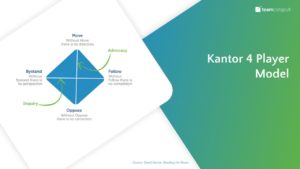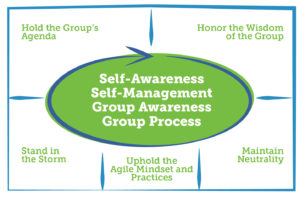As a facilitator, holding the group’s agenda is one of five guiding principles to keep the meeting moving forward.
When a group is resisting the decision they are narrowing in toward or responding with reluctance toward every attempt to move the meeting forward, you are likely encountering the tension between two unspoken but competing agendas in the room.
The principle we are looking at today, ‘holding the group’s agenda, is about continually asking “How can I best serve this group?”. It’s about wondering “ What does this group really need right now?” It’s letting your agenda take the backseat so that you can help a group tackle emergent dynamics. It’s about uncovering what’s really going on in the group so that they can move forward as a team.
The Three Group Agendas To Hold When Facilitating
The first step when it comes to holding the group’s agenda is to understand that there are three different levels of agendas that a group can have:
- The Presenting Agenda
- The Emergent Agenda
- The Developmental Agenda
Let’s look at each of these separately
The Presenting Agenda
This agenda, the presenting agenda encompasses the meeting’s purpose, desired outcomes, and plan. It’s why this group has come together, and it includes the facilitation design anticipated to help the group achieve what it hopes to achieve.
The Emergent Agenda
The emergent agenda is what emergentes live in the room as conversations happen, new perspectives are voiced, and ideas are generated.
New thinking is often behind the emergence of this level of group agenda.
The Developmental Agenda
The developmental agenda is a deeper agenda that focuses on how the group works together. It’s about group behavior and dynamics. Facilitators working with agile teams are not just trying to help a group achieve an outcome for a meeting, they are often helping a team develop.
Hold the Group’s Agenda, Not Your Own!
When you, the group facilitator, work with a group, it’s helpful to know where they want to go. Knowing their presenting agenda enables your to hold their desired outcome – what they hope to achieve from working together – and more fully comprehend what else is happening in the room.
Because along their journey, groups can get in their own way, and it can get especially complicated as a facilitator when what the group thinks they need and what they actually need are two different things.
When you hold the group’s agenda – presenting, emergent, or developmental – you are choosing to be of service to the group over yourself, your position, and your perception of our own worth.
This is about them, not you!
The principle of holding the group’s agenda is about being aware of what the group wants and how they also might be getting in their own way. It’s about being able to really listen to what’s emerging in the team – hearing what the team needs – while remaining aware of what your own agenda might be and not letting it take over.
Go Slow To Go Fast
The slippery slope with agendas is that when your own agenda feels so right to you, you risk missing the group’s agenda. And if you are facilitating a team in which you are a member of the team, discerning your agenda from the team’s agenda becomes even more difficult.
In my book ‘The Art & Science of Facilitation’ I go deeper into these agendas and show what holding the group’s agenda looks like in practice!
“You owe it to yourself and the team to challenge the notion of certain agendas”
Holding the Group’s Agenda is Big Work!
The way to change meetings is to help teams and groups move the meeting from a surface-level conversation where they may as well be rearranging the deckchairs on the Titanic to a place where it’s okay and even expected to have real conversations.
Most groups need guidance and help getting to this place, and the organization’s culture and team dynamics will have a big impact on how easy the process is.
There is work to do. Without it, you’re wasting time – yours and everyone else’s.
Don’t shy away from emergent and developmental agendas,, even when it’s tough. This work lays the track for agile teams to become agile, and each meeting is a meaningful step toward more systemic change within the team or organizational culture.
The Five Cornerstones of the Agile Team Facilitation Stance
The cornerstones of the Agile Team Facilitation Stance include:
- Honoring the wisdom of the group
- Maintaining Neutrality
- Upholding the Agile Mindset and Practices
- Standing in the Storm
- Holding the Group’s Agenda
Learn more about each stance by clicking the links!

